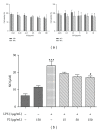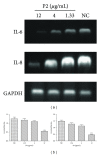The inhibitory effect of a novel polypeptide fraction from Arca subcrenata on cancer-related inflammation in human cervical cancer HeLa cells
- PMID: 24683359
- PMCID: PMC3934088
- DOI: 10.1155/2014/768938
The inhibitory effect of a novel polypeptide fraction from Arca subcrenata on cancer-related inflammation in human cervical cancer HeLa cells
Abstract
Inflammation is known to be closely associated with the development of cancer. The study was launched in human cervical cancer HeLa cells to investigate the antitumor and anti-inflammatory effects of P2, a marine polypeptide fraction from an important fishery resource Arca subcrenata. The basic research showed that P2 could suppress the production of nitric oxide in LPS-induced RAW264.7 macrophage cells as well as the secretion of inflammatory cytokines IL-6 and TNF- α in human cervical cancer HeLa cells. For the molecular mechanisms, P2 was shown to downregulate the gene expression of proinflammatory cytokines IL-6 and IL-8 and to inhibit the COX-2 and iNOS-related pathways in HeLa cells. In consequence, P2 might inhibit tumor development by blocking the interaction between tumor microenvironment and proinflammatory mediators. All findings indicate that P2 possesses the potential to be developed as a novel agent for cancer therapy.
Figures




Similar articles
-
Antitumor effect of a polypeptide fraction from Arca subcrenata in vitro and in vivo.Mar Drugs. 2012 Dec;10(12):2782-94. doi: 10.3390/md10122782. Mar Drugs. 2012. PMID: 23342393 Free PMC article.
-
Polypeptide Fraction from Arca subcrenata Induces Apoptosis and G2/M Phase Arrest in HeLa Cells via ROS-Mediated MAPKs Pathways.Evid Based Complement Alternat Med. 2015;2015:930249. doi: 10.1155/2015/930249. Epub 2015 May 21. Evid Based Complement Alternat Med. 2015. PMID: 26089952 Free PMC article.
-
Anti-inflammatory effects of ethyl acetate fraction from Melilotus suaveolens Ledeb on LPS-stimulated RAW 264.7 cells.J Ethnopharmacol. 2009 May 4;123(1):97-105. doi: 10.1016/j.jep.2009.02.024. Epub 2009 Mar 3. J Ethnopharmacol. 2009. PMID: 19429346
-
Ethyl acetate fraction from Nymphaea hybrida Peck modulates inflammatory responses in LPS-stimulated RAW 264.7 cells and acute inflammation murine models.J Ethnopharmacol. 2021 Apr 6;269:113698. doi: 10.1016/j.jep.2020.113698. Epub 2020 Dec 15. J Ethnopharmacol. 2021. PMID: 33338590
-
Effect of 1-Carbaldehyde-3,4-dimethoxyxanthone on Prostate and HPV-18 Positive Cervical Cancer Cell Lines and on Human THP-1 Macrophages.Molecules. 2021 Jun 18;26(12):3721. doi: 10.3390/molecules26123721. Molecules. 2021. PMID: 34207168 Free PMC article.
Cited by
-
Granulocyte Macrophage-Colony Stimulating Factor (GM-CSF) Downregulates the Expression of Protumor Factors Cyclooxygenase-2 and Inducible Nitric Oxide Synthase in a GM-CSF Receptor-Independent Manner in Cervical Cancer Cells.Mediators Inflamm. 2015;2015:601604. doi: 10.1155/2015/601604. Epub 2015 Jul 15. Mediators Inflamm. 2015. PMID: 26257474 Free PMC article.
-
Albumin-encapsulated Nanoparticles of Naproxen Platinum(IV) Complexes with Inflammation Inhibitory Competence Displaying Effective Antitumor Activities in vitro and in vivo.Int J Nanomedicine. 2021 Aug 14;16:5513-5529. doi: 10.2147/IJN.S322688. eCollection 2021. Int J Nanomedicine. 2021. PMID: 34429597 Free PMC article.
-
Molluscan Compounds Provide Drug Leads for the Treatment and Prevention of Respiratory Disease.Mar Drugs. 2020 Nov 19;18(11):570. doi: 10.3390/md18110570. Mar Drugs. 2020. PMID: 33228163 Free PMC article. Review.
-
The Potential Role of Nitric Oxide in Halting Cancer Progression Through Chemoprevention.J Cancer Prev. 2016 Mar;21(1):1-12. doi: 10.15430/JCP.2016.21.1.1. Epub 2016 Mar 30. J Cancer Prev. 2016. PMID: 27051643 Free PMC article. Review.
-
Oceans as a Source of Immunotherapy.Mar Drugs. 2019 May 10;17(5):282. doi: 10.3390/md17050282. Mar Drugs. 2019. PMID: 31083446 Free PMC article. Review.
References
-
- Kumar NSS, Nazeer RA, Jaiganesh R. Purification and identification of antioxidant peptides from the skin protein hydrolysate of two marine fishes, horse mackerel (Magalaspis cordyla) and croaker (Otolithes ruber) Amino Acids. 2012;42(5):1641–1649. - PubMed
-
- Wu SC, Zhang ZX. Scavenging effects of extracts of Scapharca subcrenata on oxygen free radical. Modern Food Sciences and Technology. 2010;26(3):238–240.
-
- Yoon NY, Kim HR, Chung HY, Choi JS. Anti-hyperlipidemic effect of an edible brown algae, Ecklonia stolonifera, and its constituents on poloxamer 407-induced hyperlipidemic and cholesterol-fed rats. Archives of Pharmacal Research. 2008;31(12):1564–1571. - PubMed
-
- Feng Y-W, Li Q, Kong L-F. Isolation and characterization of 14 polymorphic microsatellite loci in the ark shell Scapharca subcrenata (Bivalvia: Arcidae) Conservation Genetics. 2009;10(4):1125–1127.
-
- Guo XS, Li Y. Marine Traditional Chinese Medicines. Beijing, China: Sciences Press; 2003.
Publication types
MeSH terms
Substances
LinkOut - more resources
Full Text Sources
Other Literature Sources
Medical
Research Materials

